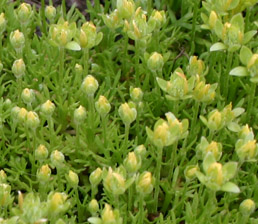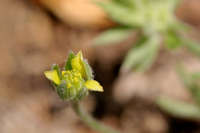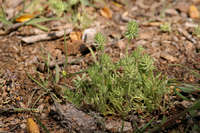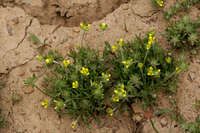|
|
|
|
Family: Ranunculaceae
curveseed butterwort
[Ceratocephala testiculata (Crantz) Roth, moreRanunculus testiculatus Crantz] |
Stems erect or ascending, not rooting nodally, villous, not bulbous-based. Tuberous roots absent. Basal leaf blades broadly spatulate in outline, 1-2×-dissected, 0.9-3.8 × 0.5-1.5 cm, segments linear, margins entire, apex obtuse to acuminate. Flowers: receptacle glabrous; sepals spreading, 3-6 × 1-2 mm, villous; petals yellow, 3-5 × 1-3 mm. Heads of achenes cylindric, 9-16(-27) × 8-10 mm; achenes 1.6-2 × 1.8-2 mm, tomentose; beak persistent, lanceolate, 3.5-4.5 mm. Flowering spring (Apr-May). Disturbed areas, especially in grassland; 400-2500 m; introduced; B.C., Sask.; Ariz., Calif., Colo., Idaho, Iowa, Kans., Minn., Mo., Mont., Nebr., Nev., N.Mex., N.Dak., Ohio, Oreg., S.Dak., Utah, Wash., Wyo.; native to Eurasia. In North America, Ranunculus testiculatus seems to be expanding its range rapidly in arid and semiarid areas. A second species of this subgenus, R . falcatus Linnaeus [ Ceratocephala falcata (Linnaeus) Persoon], has been reported from North America, but all reports seem to be based on misidentified material of R . testiculatus .
Small, scapose annual to 1 dm, thinly silky- tomentose; lvs 1-4 cm, ternate or biternate with narrow segments; sep greenish, ovate-lanceolate, persistent, accrescent to 5-6 mm; pet narrow, 4-8 mm, pale yellow, fading to whitish with pink veins; achenes (25-)35-70, widely spreading, forming a cylindric or ovoid bur (1-)1.5-2.5 cm, individually 5-7 mm, 3-locellar, the central chamber with a single seed, the 2 empty lateral chambers bulged-inflated on the upper side, the abrupt stiff beak longer than the body. Vernal ephemeral Eurasian weed, now widespread in w. U.S. and occasionally intr. with us, as in Io. and O. (Ceratocephalus t.) Gleason, Henry A. & Cronquist, Arthur J. 1991. Manual of vascular plants of northeastern United States and adjacent Canada. lxxv + 910 pp. ©The New York Botanical Garden. All rights reserved. Used by permission. General: Introduced annual, 1.5-10 cm tall; stems erect or ascending, villous; tuberous roots absent. Leaves: Basal, broadly spatulate in outline, 0.9-3.8 cm long, 0.5-1.5 cm wide, 1-2 times dissected, the segments linear, glabrous to villous, margins entire, apex obtuse to acuminate; petioles 0.5-3 cm long, winged. Flowers: Inflorescence a cyme, 1- to several-flowered; pedicels hirsute; sepals 5, 4-6 mm long, glabrous or hirsute; petals 5, 4-6 mm long, yellow; nectary scale attached basally, forming a flap over the nectary; flowers July- August. Fruits: Achene, numerous, arranged in a cylindric head, 9-27 mm long, 8-10 mm wide; body of achene 1.6-2 mm long, tomentose, the beak lanceolate, 3.5-4.5 mm long, usually much longer than the body. Ecology: Disturbed habitats, roadsides, grasslands, pinyon-juniper woodlands, ponderosa pine forests, dry soils; 1200-2300 m (4000-7500 ft); Apache, Coconino, Maricopa, Mohave, and Yavapai counties; central, northwestern, and southwestern U.S. Notes: This species is recognizable from most of the other buttercups by its 3-chambered achenes, finely divided leaves, scapose habit, and villous hairs. It also typically occurs in dry habitats. Editor: Springer et al. 2008 |





